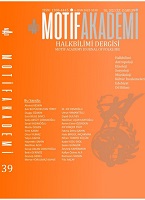GELENEKSEL TÜRK EVİNDEN ÇOK KATLI BİNALARA: KENTSEL MİMARİNİN ELEŞTİRİSİ
FROM TRADITIONAL TURKISH HOUSES TO MULTI-STOREY BUILDINGS: A CRITICISM OF URBAN ARCHITECTUR
Author(s): Neslihan AvciSubject(s): Customs / Folklore, Architecture, Rural and urban sociology
Published by: Motif Halk Oyunları Eğitim ve Öğretim Vakfı
Keywords: Turkish House; Folklore; Urban Architecture; Multi-Storey Buildings; Searching for Solutions;
Summary/Abstract: While the industrialization process, which started in the 1950s in Turkey and accelerated with the development of transportation vehicles and technology, caused migration from rural to urban areas, it also made the first manifestations of irregular urbanization visible. This situation has disrupted the folklore practices that the Turkish people, who came from the nomadic equestrian culture, acquired under difficult living conditions and inherited from the periods when they settled down. The changes experienced in the transition from horizontal to vertical residential architecture have caused the Turkish people to continue their habits from the past by living a life in between. In addition to this, Turkish people, who attach importance to privacy, have opened the door to search for new solutions suitable for their own understanding of life on the threshold of another privacy. In this research, it has been examined how the changes experienced in the transition from traditional Turkish houses, which have deep meanings regarding Turkish culture, to multi-storey buildings have created a transformation on the perception of the house and daily life practices. In this context, it is aimed to convey the problems encountered in apartments and the search for solutions in the language of a total of 18 resource people in the sample of Istanbul, where the phenomenon of urbanization is the most intense. The research was carried out by interview and observation method, and a sound recording was obtained. As a result of the findings obtained in the research, it was concluded that urban architecture could not connect with Turkish people and could not adequately respond to daily needs.
Journal: Motif Akademi Halkbilimi Dergisi
- Issue Year: 15/2022
- Issue No: 39
- Page Range: 858-882
- Page Count: 25
- Language: Turkish

